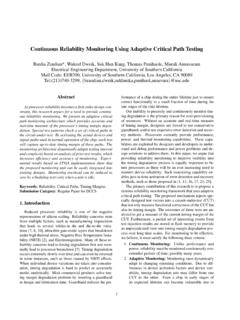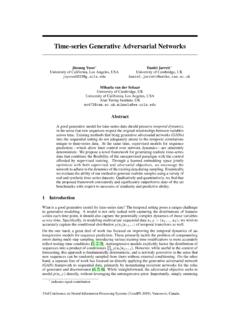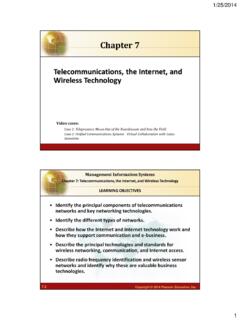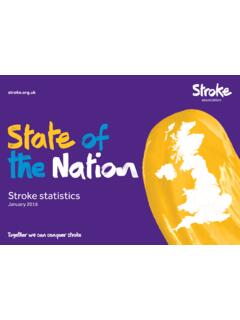Transcription of An Introduction to Wireless Sensor Networks
1 An Introduction to Wireless Sensor Networks Bhaskar Krishnamachari Autonomous Networks Research Group Department of Electrical Engineering USC Viterbi School of Engineering ~bkrishna/. Tutorial Presented at the Second International Conference on Intelligent Sensing and Information Processing (ICISIP), Chennai, India, January 2005. Bhaskar Krishnamachari 2005, All Rights Reserved 1. Overview Bhaskar Krishnamachari 2005 2. Wireless Sensor Networks (WSN). The many - tiny principle: Wireless Networks of thousands of inexpensive miniature devices capable of computation, communication and sensing Their use throughout society could well dwarf previous milestones in the information revolution : National Research Council Report, 2001. Berkeley Mote (MICAz MPR 2400 Series). Bhaskar Krishnamachari 2005 3. Timeline 1970's: Wired sensors connected to central location 1980's: Distributed wired Sensor Networks 1993: LWIM project at UCLA. 1999-2003: DARPA SensIT project: UC Berkeley, USC, Cornell etc.
2 2001: Intel Research Lab at Berkeley focused on WSN. 2002: NSF Center for Embedded Networked Sensing 2001-2002: Emergence of Sensor Networks industry; startup companies including Sensoria, Crossbow, Ember Corp, SensiCast plus established ones: Intel, Bosch, Motorola, General Electric, Samsung. 2003-2004: IEEE standard, Zigbee Alliance. Bhaskar Krishnamachari 2005 4. Wireless Sensor Networks (WSN). Provide a bridge between the real physical and virtual worlds Allow the ability to observe the previously unobservable at a fine resolution over large spatio-temporal scales Have a wide range of potential applications to industry, science, transportation, civil infrastructure, and security. Bhaskar Krishnamachari 2005 5. Some Sample Applications Habitat and Ecosystem Monitoring Seismic Monitoring Civil Structural Health Monitoring Monitoring Groundwater Contamination Rapid Emergency Response Industrial Process Monitoring Perimeter Security and Surveillance Automated Building Climate Control Bhaskar Krishnamachari 2005 6.
3 Basic Components of a WSN Node Bhaskar Krishnamachari 2005 7. Challenges Energy Efficiency Responsiveness Robustness Self-Configuration and Adaptation Bhaskar Krishnamachari 2005 8. Challenges (contd.). Scalability Heterogeneity Systematic Design Privacy and Security Bhaskar Krishnamachari 2005 9. Outline for the Rest of the Tutorial Deployment Localization Time Synchronization Wireless Link Characteristics Medium Access Sleep Based Topology Control Routing Data Centric Networking Transport Bhaskar Krishnamachari 2005 10. Deployment Bhaskar Krishnamachari 2005 11. Deployment Issues Structured versus Randomized Deployment Overdeployed versus Incremental Deployment Connectivity and Coverage Metrics of Interest Bhaskar Krishnamachari 2005 12. network Topologies Bhaskar Krishnamachari 2005 13. Random Graph Models For some applications, WSN nodes could be scattered randomly ( from an airplane). Random Graph Theory is useful in analyzing such deployments The most common random graph model is G(n,R): deploy n nodes randomly with a uniform distribution in a unit area, placing an edge between any two that are within Euclidean range R.
4 Bhaskar Krishnamachari 2005 14. Geometric Random Graph G(n,R). sparse dense Bhaskar Krishnamachari 2005 15. Some Key Results All monotone graph properties have an asymptotic critical range R beyond which they are guaranteed with high probability (Goel, Rai, and Krishnamachari 04). The critical range for connectivity is (Penrose 97, Gupta and Kumar 98). The critical range to ensure that all nodes have at least k neighbors also ensures k-connectivity (Penrose 99). Bhaskar Krishnamachari 2005 16. Connectivity in G(n,R). Bhaskar Krishnamachari 2005 17. Power Control Provides a degree of flexibility in configuring the network connectivity after deployment. Must carefully balance several factors, including connectivity, energy usage, and interference. The CBTC (Li et al. 01) provides a distributed rule for global connectivity: increase power until there is a neighbor within range in every sector of angle 5 /6. Bhaskar Krishnamachari 2005 18. Coverage Metrics Much more application specific than connectivity.
5 Some that have been studied in particular detail are: Path observation metrics: An example of this is the maximal breach distance, defined as the closest any evasive target must get to a Sensor in the field (Meguerdichian et al. 99). K-Coverage: ensure that all parts of the field are within sensing range of K sensors ( Wang et al. 03). Bhaskar Krishnamachari 2005 19. Key Results on K-Coverage A field is K-covered if and only if all intersection points between sensing circles are at or inside the boundary of K+1 sensing circles. (Wang et al. 03). If a region is K-covered by n sensors, they also form a K- connected graph if their communication range is at least twice the communication range. (Wang et al. 03). Bhaskar Krishnamachari 2005. A 2-covered region 20. Localization Bhaskar Krishnamachari 2005 21. Localization Issues Location information necessary/useful for many functions, including measurement stamps, coherent signal processing, cluster formation, efficient querying and routing.
6 Key Questions: What to localize? When to localize? How well to localize? How to localize? Bhaskar Krishnamachari 2005 22. Coarse Grained Node Localization Several techniques provide approximate solutions for node localization based on the use of minimal information: Proximity Centroids Geometric Constraints APIT. Identifying Codes Bhaskar Krishnamachari 2005 23. Geometric Constraints Reference node Unknown node Constrained location region Disc Sector Quadrant Annulus Bhaskar Krishnamachari 2005 (Doherty, Pister and Ghaoui 01) 24. Approximate Point in Triangle (APIT). (He, Huang, et al. 03). Bhaskar Krishnamachari 2005 25. ID-Codes (Ray et al. 03). Bhaskar Krishnamachari 2005 26. Fine-Grained Node Localization Basic Approach: Ranging ranging using radio signal strengths (m-level accuracy). ranging using time difference of arrival (cm-level accuracy over short distances). Position estimation is then an MMSE problem: Ej = Ri,j - ((xi-xj)2+(yi-yj)2). Find (xi,yi) to minimize (Ej)2.
7 Angle of arrival techniques are particularly useful in conjunction with ranging Bhaskar Krishnamachari 2005 27. Time Difference of Arrival To Transmitter RF Acoustic Receiver Tr Ts Distance (Tr Ts) . Vs Bhaskar Krishnamachari 2005 28. Fine-Grained Node Localization (contd.). Pattern matching techniques such as RADAR (Bahl and Padmanabhan, 00) require pre-training of signal strengths at different locations in the environment. Ecolocation (Yedavalli et al. 04) is based on sequence decoding. Record the received signal strengths at different reference nodes from a given unknown node, and order these into a sequence Return as the unknown node's location the location that best matches the measured sequence Bhaskar Krishnamachari 2005 29. network Localization Different from node localization. Few reference nodes and several networked unknown nodes. Several approaches: Constraint satisfaction/optimization (centralized). Joint estimation using ranging estimates (centralized).
8 Multihop distance estimation (distributed). Iterative localization (distributed). Potential fields (distributed). Bhaskar Krishnamachari 2005 30. Iterative Localization (0,10). C F D (10,10). (5,5). E I. G L J. K. A H B. (10,0). (0,0). Bhaskar Krishnamachari 2005 31. Iterative Localization (0,10) 1. (5, 25/3). C F D (10,10). (5,5). 3 G 2 E 6 I 7. L J. K 4. A H B. 5 (10,0). (0,0). Bhaskar Krishnamachari 2005 32. Reference-less Localization What if there are no reference nodes with known locations? Three-step solution (Rao 03): 1. If all boundary nodes have known locations, use iterative centroid calculations 2. If boundary nodes do not have known locations, use pairwise hop-counts to get approximate locations and apply step 1. 3. If nodes are not aware of boundary, use a flood to identify boundary nodes and apply step 2. The solution provides only a relative map, useful for geographic routing Bhaskar Krishnamachari 2005 33. Illustration of Reference-less Localization Localization assuming only Correct locations known boundary nodes Bhaskar Krishnamachari 2005 34.
9 Rigidity and Unique Localization The network is said to be uniquely localizable if there exists a unique assignment of (x,y) coordinates to all nodes that is consistent with the available positions and distance estimates in a network . Let GN be the grounded graph, the network graph augmented with distance-labelled edges between all pairs of reference nodes. Theorem: A network is uniquely localizable if its grounded graph is globally rigid. (Eren et al. 04). Bhaskar Krishnamachari 2005 35. Global Rigidity A. Not Rigid E B E B. A. D C D C. (a) (b). A. Rigid E B E B. A. D C D C. (c) (d). Bhaskar Krishnamachari 2005 36. Time Synchronization Bhaskar Krishnamachari 2005 37. Synchronization Techniques Receiver Broadcast Synchronization: multiple receivers synchronize to the same broadcast (Elson, Girod, and Estrin 02). Timing-Sync Protocol for Sensor Nets (TPSN): traditional sender-receiver synchronization (Ganeriwal, Kumar and Srivastava 03). FTSP: Multiple time stamping at sender and receiver for each packet to mitigate processing time jitter.
10 Possible to synchronize nodes to within 1 s. (Maroti et al. 04). Bhaskar Krishnamachari 2005 38. Reference Broadcast Synchronization Bhaskar Krishnamachari 2005 39. TPSN. Bhaskar Krishnamachari 2005 40. Wireless Link Characteristics Bhaskar Krishnamachari 2005 41. Empirical Observations Early studies all assumed a simple perfect-connectivity- within-range model for simulations and analysis. A number of empirical studies suggest this can be very misleading ( Ganesan 02; Zhao and Govindan 03; Woo, Tong and Culler 03). A better characterization is that links fall into three regions: connected, transitional and unconnected. The transitional region will contain a large number of unreliable links. Bhaskar Krishnamachari 2005 42. Link Regions Bhaskar Krishnamachari 2005 43. Received Signal Strength Bhaskar Krishnamachari 2005 44. Radio Reception Bhaskar Krishnamachari 2005 45. Explanation for Link Regions (Zuniga and Krishnamachari 04). Bhaskar Krishnamachari 2005 46.









![A arXiv:1412.6572v3 [stat.ML] 20 Mar 2015](/cache/preview/d/f/b/7/2/0/c/7/thumb-dfb720c7312440923ac37a1e47ee998f.jpg)

